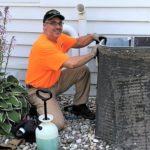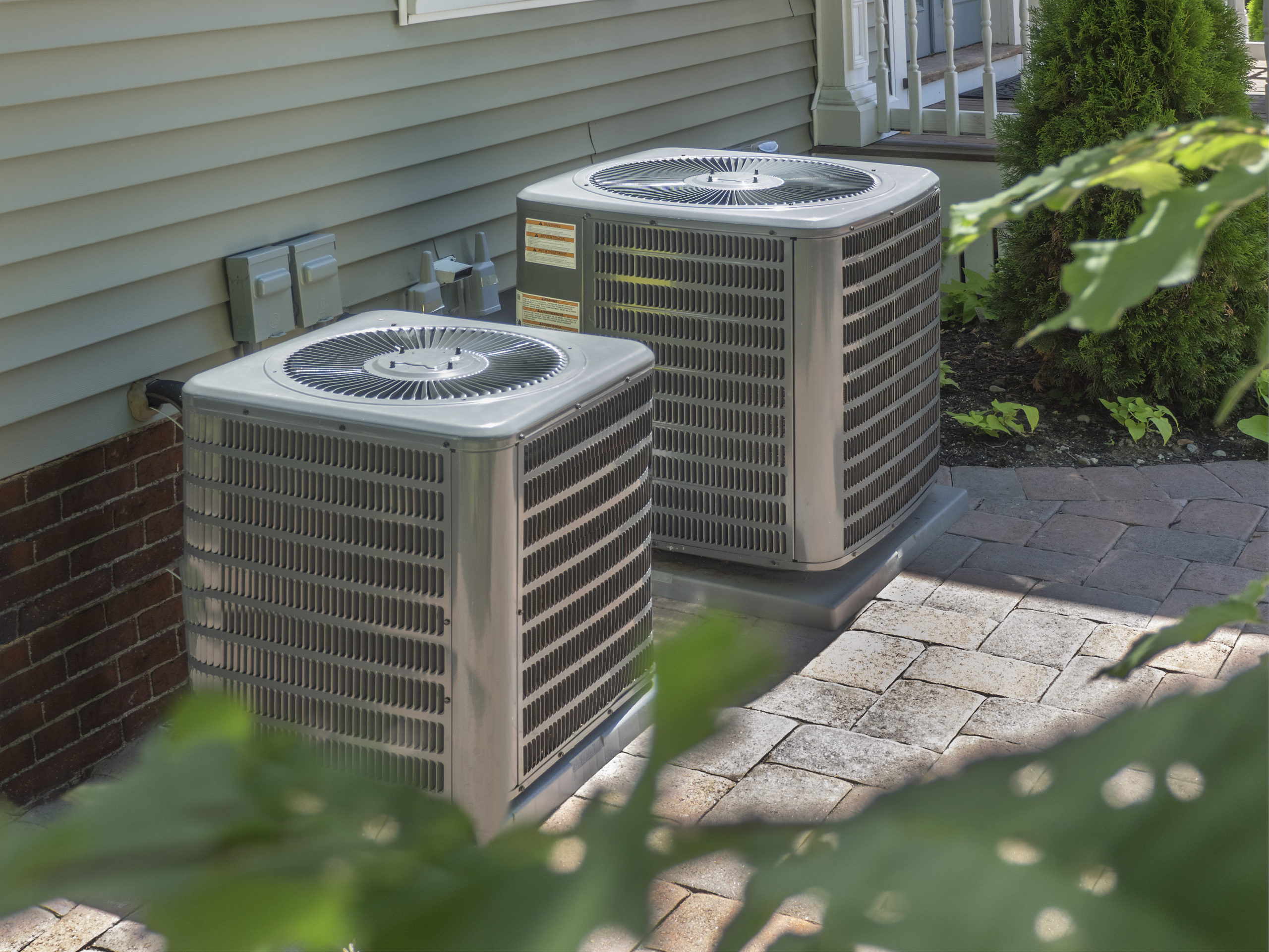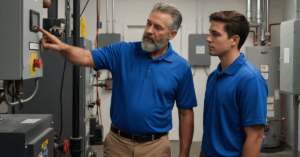The heating and air conditioning industry centers around human comfort. If we had our way, we would live the rest of our lives between 70 and 75 degrees. Because of this, the HVAC industry makes its way into almost every sector of business and every structure that is occupied by people.
The industry is vast, that’s why it’s important to get HVAC help by starting with the basics. We use the letters HVAC/R to represent the various disciplines involved. Briefly, we define them like this:
- H – Heating
- V – Ventilation
- AC – Air Conditioning
- R – Refrigeration
For now, let’s remove the V for Ventilation — bringing fresh air into buildings and exhausting stale or dirty air. Let’s also skip the R for refrigeration — primarily focused on the preservation of food. Today, we’ll look at the remaining letters, H and AC, representing Heating and Air Conditioning and explore these types of systems.
Heating Systems
If there were to be a popularity contest among different types of heating equipment, the forced-air gas furnace would be the winner. Ranging in efficiency from 80% to 98%, the gas furnace keeps millions of Americans comfortable and warm year after year. Furnaces are very reliable. Although they require periodic maintenance, we often count on them as the only heat source for a home. They are typically ducted, supplying warm air to each room and collecting cool air from central areas of the home and returning it to the equipment to be heated again.
A furnace is basically divided into two compartments, the blower section and the burner section.
The Blower
The blower section has a powerful motor capable of moving several hundred cubic feet of air every minute. This blower has a very efficient design — a centrifugal wheel that spins at about 1000 revolutions per minute.
Traditionally, these blower motors were simple air-cooled 6-pole motors, but newer furnaces are now equipped with electrically commutated motors or ECM. What makes them unique is that they are capable of operating at many different speeds. The furnace will ramp up or slow down the motor based on the needs of the home. This strategy has been used in larger commercial systems for decades to improve energy efficiency; now it’s being integrated into residential systems as well.
The Burner
The burner section of the furnace is where the real magic takes place. Fossil fuels are converted to heat using a controlled combustion process that safely manages the products of combustion, and effectively warms the air that the blower moves across the heat exchanger and through the duct system. Here’s how it works:
- When the room temperature drops below the setpoint, the thermostat sends a signal to the furnace, calling for heat.
- The heating sequence begins by starting the dedicated draft blower and verifying that the venting system is clear. After that, the ignition system prepares to ignite the fuel gas, at the precise moment the gas control valve opens and gas is metered through small orifices into each burner where it ignites to a temperature of about 3000 degrees and begins to warm up the heat exchanger.
- Heat exchangers typically have a serpentine design that routes these hot flue gasses through longer passages, to extract as much heat as possible. Furnaces with a single heat exchanger will utilize 80% of the heat, releasing about 20% out through the flue piping. However, high-efficiency furnaces include a second heat exchanger that removes even more heat from the flue gases bringing them down in temperature close to 100 degrees, and thereby using well over 90% of the heat from the combustion process. This minimizes the gas usage and saves money on the homeowner’s utility bill.
- As the heat exchanger warms up, the blower comes on, drawing the cooler air from the home and blowing it across the heat exchanger at a velocity of about 1000 feet per minute. It raises the air temperature about 50 degrees as it passes through the furnace and forces it out into each room.
- The air distribution system takes it from there, sending more air to the rooms that require it and less to rooms that don’t.
When the thermostat senses that the room is up to the desired temperature, it dismisses the call for heat and the burners shut down immediately. The blower continues to run, for a minute or two, to extract every last bit of heat left behind from the combustion process before it slows to a halt. With the sequence complete, the unit stands at the ready, like a sentry keeping watch over your comfort on a cold wintry night.
Air Conditioning Systems
As the faithful furnace awaits your next comfort request, it is set up to work with a split-system air conditioner to keep you cool while the temperature outside is rising. A split-system air conditioner is a marvel of science, harnessing the power of pressures and temperatures to remove heat (and humidity) from your home and release it outdoors where it belongs. This is the type of equipment that is most widely used for residential and some commercial cooling applications. The name “split” stems from the arrangement of the two main components. The evaporator coil, on the inside of the building and the condensing unit that is placed outside. Both components of the split-system are connected by refrigerant piping and control wires.
Here’s an explanation of how the system works:
When the temperature in the house creeps up above the set point, the thermostat sends a signal to the furnace to turn on the blower and the condensing unit outside. This type of air conditioning system is called a vapor compression system and that’s exactly what the compressor does, it compresses vapor refrigerant pushing its temperature high enough that we can actually cool it down with outside air.
What happens in the condenser is pure physics, as it harnesses the power of latent heat transfer.
- When a substance changes its physical state, from vapor to liquid, it releases a tremendous amount of heat.
- Thousands of BTU’s are removed from the refrigerant as the outdoor fan pulls air through the condensing coil changing it from a vapor into a liquid, thus the name condenser. Lean over an air conditioner on a hot day and you’ll feel the upblast of heat blowing straight at you; that is the latent heat being removed from the refrigerant.
- Once the condenser does a thorough job of converting all that vapor refrigerant into liquid, we send it through the refrigerant piping, into the house, toward the cooling coil that typically sets on top of the furnace.
Before our high-pressure liquid refrigerant enters the evaporator, we must first encounter the metering device. This device is like a toll booth on the expressway, slowing down all the traffic and only letting through a few cars at a time.
- The metering device opposes the pressure created by the compressor, dividing the system into what we call the “high side” and the “low side.”
- When the refrigerant experiences this drop in pressure it immediately reacts with a drop in temperature changing from more than 100 degrees, down to a perfect chill of about 40 degrees.
- These cool droplets of refrigerant leaving the metering device are ready to absorb heat from the home, and the furnace blower and duct system are ready to provide it.
- As warm air passes over the cool evaporator coil, heat is transferred from the air, to the refrigerant using the same principle of physics we saw in the condenser.
- The refrigerant changes its physical state, from liquid to vapor this time, and in the process, absorbs an equal amount of heat.
- The same quantity of heat released by the condenser is absorbed in the evaporator and the cycle goes on and on.
The evaporator however, is a workhorse. It has two jobs. It not only removes heat from the air, but it also removes moisture. When the air in a home is heavy with humidity, the cold evaporator collects it in the form of condensation. As water vapor condenses on the coil’s surface, it releases even more heat into the refrigerant and sends all of it, outside, through another refrigerant line, back to the condenser for another cycle of vapor-compression cooling.
Whether we are discussing furnaces or air conditioners, boilers or heat pumps, all of these mechanical devices use different sources of energy to add or remove heat. That is what HVAC/R is, an entire industry devoted to keeping people comfortable, at home or school, work or play. We are practitioners of pressure and temperature and commanders of BTU’s, directing them to go where we want them to go.
A person can spend their entire career specializing in one type of HVAC/R system or servicing a variety of equipment. The best way to find your fit is to learn a little about each of them, and pursue your interest from there. A great place to start is, Interplay Learning’s What is HVAC? course, where you’ll learn all the systems and components of a system, as well as, information about the industry.

Frank Garro
Interplay Learning Plumbing & HVAC Expert
Frank is Interplay’s resident plumbing and HVAC expert. While he began his career in the plumbing trade, his passion for HVAC led him to become an Associate Professor and HVAC Program Chair, at Ivy Tech Community College. Frank is a Licensed Mechanical, Plumbing and Electrical Contractor, and owns his own mechanical services company. As an educator, Frank is a firm believer in teaching the fundamentals and has a gift for simplifying complex concepts.




